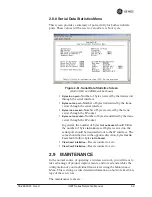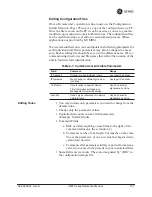
92
iNET Series Reference Manual
05-2806A01, Rev. H
•
Packets sent
—Over-the-air data packets sent by this Remote.
•
Bytes received
—Over-the-air data bytes received by this Remote.
•
Bytes sent
—Over-the-air data bytes sent by this Remote.
•
Packets dropped
—To-be-transmitted packets dropped as a result
of a lack of buffers in the RF outbound queue.
•
Receive errors
—Packets that do not pass CRC. This may be due
to transmissions corrupted by RF interference.
•
Retries
—Number of requests to re-send a data packet before it is
acknowledged. If the packet was not acknowledged, this
counter is not incremented.
•
Retry errors
—Packets discarded after exceeding seven retries
over-the-air.
•
Clear Wireless stats
—Resets the statistics counter.
Ethernet Packet Statistics
•
Packets received
—Packets received by the transceiver through
the Ethernet port.
•
Packets sent
—Packets transmitted by the transceiver through the
Ethernet port.
•
Bytes received
—Data bytes received by this Remote through its
LAN port.
•
Bytes sent
—Data bytes sent by this Remote.
•
Packets dropped
—Received packets dropped as a result of a lack
of buffers.
•
Receive errors
—Packets that do not pass CRC. This may be due
to collisions in the Ethernet LAN.
•
Lost carrier detected
—A count of the number of packets that the
unit attempted to send out the Ethernet port when the carrier sig-
nal of the Ethernet was not present. (No carrier present could be
due to a loose connection, bad or wrong cable, or equipment
failure at the other end of the Ethernet cable.)
•
Clear Ethernet stats
—Resets the statistics counter.
•
Wireless Packet Statistics
(when VLAN is shown)—A screen
almost identical to Figure 2-53 is shown, except that option D
(VLAN Packet Stats) appears as in Figure 2-54 below.
Summary of Contents for MDS iNET 900
Page 12: ...2 iNET Series Reference Manual 05 2806A01 Rev H ...
Page 32: ...22 iNET Series Reference Manual 05 2806A01 Rev H ...
Page 122: ...112 iNET Series Reference Manual 05 2806A01 Rev H ...
Page 124: ...114 iNET Series Reference Manual 05 2806A01 Rev H ...
Page 136: ...126 iNET Series Reference Manual 05 2806A01 Rev H ...
Page 138: ...128 iNET Series Reference Manual 05 2806A01 Rev H ...
Page 162: ...152 iNET Series Reference Manual 05 2806A01 Rev H ...
Page 164: ...154 iNET Series Reference Manual 05 2806A01 Rev H ...
Page 174: ...164 iNET Series Reference Manual 05 2806A01 Rev H ...
Page 182: ...172 iNET Series Reference Manual 05 2806A01 Rev H ...
















































